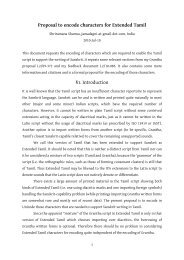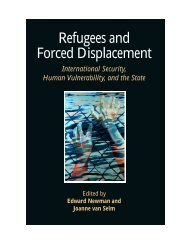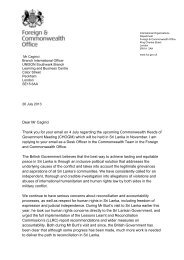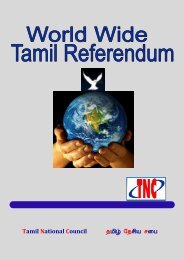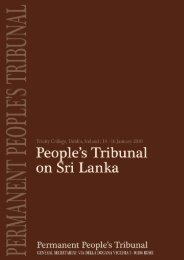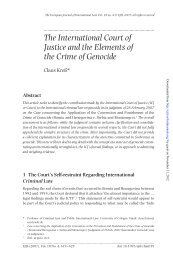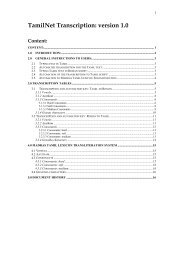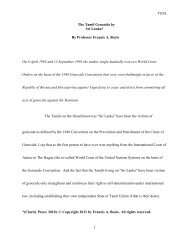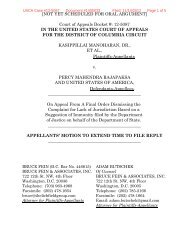Untitled - International Commission of Jurists
Untitled - International Commission of Jurists
Untitled - International Commission of Jurists
Create successful ePaper yourself
Turn your PDF publications into a flip-book with our unique Google optimized e-Paper software.
The indiscriminate nature <strong>of</strong> these reprisal attacks have been generally attributed to<br />
the isolated, tense and fearful context in which soldiers operate in the conflict areas,<br />
prevented from associating with the civilian population and compelled to contend<br />
with the brutal tactics <strong>of</strong> the LTTE. 180 In certain instances however, the names <strong>of</strong> the<br />
same perpetrators emerge repeatedly in the records, thus suggesting the existence <strong>of</strong> a<br />
small band <strong>of</strong> soldiers who are moved with <strong>of</strong>ficial sanction from place to place in<br />
order to carry out such attacks with the intention <strong>of</strong> causing the same amount <strong>of</strong> terror<br />
as the LTTE. The other cases concern periodic mass killings that had occurred during<br />
the course <strong>of</strong> the conflict in the North and East. 181<br />
4.3.1. The Kumarapuram Case<br />
Unlike in many other areas, the army detachment near the Kumarapuram village in<br />
Trincomalee District had been co-existing amicably with the nearby villagers who<br />
were <strong>of</strong> Sinhalese, Muslim and Tamil ethnicity. 182 However, tensions had arisen in the<br />
mid-1990s following the posting <strong>of</strong> a senior army <strong>of</strong>ficer to that detachment. On 11<br />
February, 1996, 24 Tamil civilians were massacred, including six women amidst and<br />
thirteen children, ostensibly as a result <strong>of</strong> the killing <strong>of</strong> two soldiers at Dehiwatte<br />
junction by the LTTE. Senior <strong>of</strong>ficers did not intervene during this reprisal massacre,<br />
which lasted for about two hours.<br />
Once the details <strong>of</strong> the massacre emerged, widespread public anger 183 led to the<br />
formation <strong>of</strong> a military board <strong>of</strong> inquiry. 184 The inquiry recommended the punishment<br />
<strong>of</strong> senior <strong>of</strong>ficers for their acts <strong>of</strong> culpable omission in standing idly by while the<br />
villagers were massacred. Sixteen army personnel were arrested and an identification<br />
parade was held. However, there were errors in the conducting <strong>of</strong> this parade. Many<br />
<strong>of</strong> the witnesses from whom original statements were recorded were not called to<br />
participate. Further, some accused were not summoned to participate in the line-up. 185<br />
Subsequent to the parade, eight army personnel, seven <strong>of</strong> Sinhalese ethnicity and one<br />
<strong>of</strong> Muslim ethnicity, were identified and remanded. However, they were released<br />
before the non-summary inquiry commenced. Indictment was not served on the<br />
180 Hyndman, Patricia, ‘Democracy in Peril’, Report to the Law Asia Human Rights Standing<br />
Committee, 1985, at p. 65.<br />
181 United Nations Working Group on Enforced or Involuntary Disappearances, Report <strong>of</strong> the Working<br />
Group on Enforced or Involuntary Disappearances (5-15 October 1992), E/CN4./1993/25/Add.1,<br />
Presented to the UN <strong>Commission</strong> on Human Rights at its 50 th sessions, at p. 3. The cases examined in<br />
this section are illustrative <strong>of</strong> systemic patterns <strong>of</strong> impunity. An exhaustive compilation <strong>of</strong> relevant<br />
cases would be much longer. Other instances <strong>of</strong> killings, such as the reprisal killings <strong>of</strong> Tamil civilians<br />
by Muslim home guards on 29 April, 2002 at Karapola and Muthugala resulting in the killing <strong>of</strong> 88<br />
civilians, did not lead to anything beyond a brief inquiry.<br />
182 University Teachers for Human Rights (Jaffna), ‘Trincomalee District in February 1996: Focusing<br />
on the Killiveddy Massacre,’ Information Bulletin No.10, 02.03.1996.<br />
183 ibid. ‘We also assert here that the Sinhalese in the area (were) very much upset by the incident and<br />
were full <strong>of</strong> sympathy for the people <strong>of</strong> Kumarapuram. Buddhist monks in Trincomalee who were<br />
contacted had also expressed their grief. It is also noteworthy that among those who visited<br />
Kumarapuram and consoled the people was a Buddhist monk from the area.’<br />
184 Established on 15.02.1996 headed by Major-General E.H. Samaratunge and comprising the late<br />
Brigadier Parami Kulatunge and Lt. Colonel Asoka Padeniya.<br />
185 Movement for Interracial Justice and Equality, ‘Kumarapuram Massacre and Legal Proceedings,’<br />
April 1997, at p. 2.<br />
60



